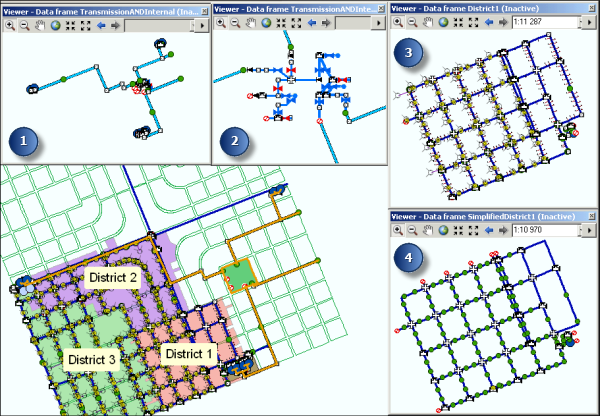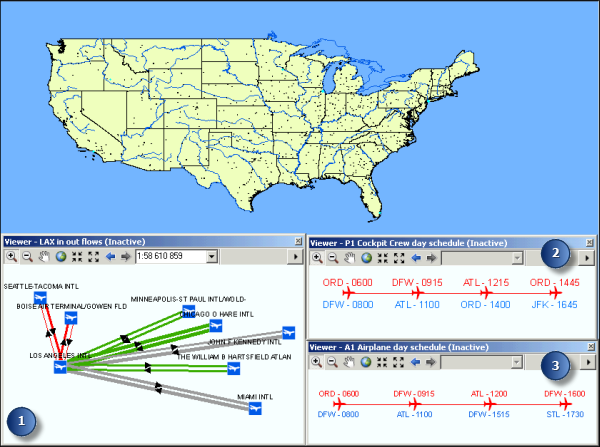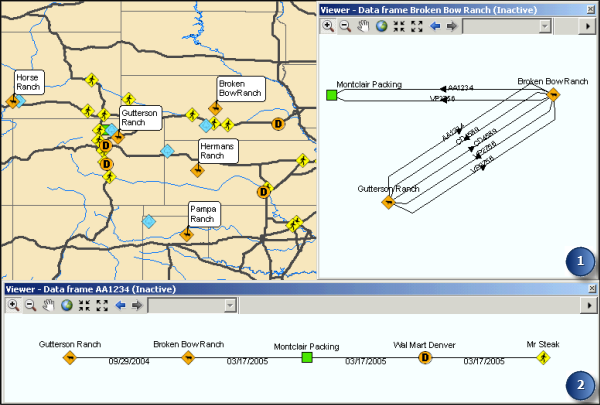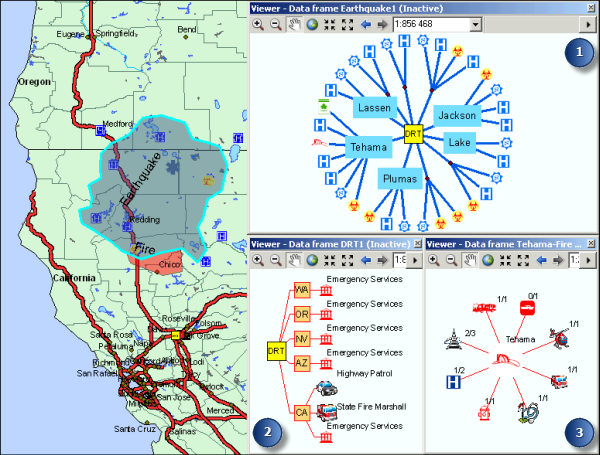What are schematics?
Schematics are simplified representations of networks, intended to explain their structure and make the way they operate understandable. Schematics can be used to represent any type of network within a defined space without scaling constraints. For example, a defined space is a piece of paper where numerous pieces of information are displayed by optimizing the placement of the features. Within schematics, there are no scale constraints (cable length, distances, and so forth).
By allowing users to efficiently create multilevel representations, readily check network connectivity, and easily obtain logical views of any linear network, the Erweiterung "ArcGIS Schematics" improves efficiency and facilitates the decision-making process. The Erweiterung "ArcGIS Schematics" allows you to do the following:
- Automatically generate schematics from complex networks
- Check network connectivity
- Perform quality control of network data
- Optimize network design and analysis
- Forecast and plan (for example, conduct modeling, simulation, and comparative analysis)
- Dynamically interact with geographic information system (GIS) software through a schematic view
- Perform commercial and market analyses
- Model social networks
- Generate flowcharts
- Manage interdependencies
Schematics and utilities
Schematic representations are used by the following industries and utility companies:
- Telecommunications
- Energy
- Water and wastewater
- Transportation
- Electric and gas
- Petroleum and pipeline
- Hydrology
- Local government
- Defense and intelligence
- Schematically view their network data
- Evaluate existing networks and plan network evolution
- Model and design their networks
- Distinguish topological relationships
- Find ways to optimize their systems
Electric utility sample
- Schematics can be used to produce diagrams from electric GIS features combined with nonspatial objects, which show the internal connections of an electric facility (viewer window 1).
- A set of customizable schematic layout algorithms can be used to quickly lay out schematic diagram contents and get a logical and physical display, provide a better understanding of how a network is organized, and help accelerate the decision cycle (viewer window 2).
- Schematics can be used to produce interior substation diagrams that are not typically viewable in the GIS.

Water industry sample
Schematics can be used to build different types of schematic diagrams such as the following:
- Transmission (viewer window 1) or distribution diagrams
- Pumping station plant (viewer window 2)
- Water network diagrams per district, county, and so on (viewer window 3)
- Simplified diagrams of water equipment to clearly highlight the elements that control the valves in the network (viewer window 4)

Schematics and nontraditional applications
Other sectors that benefit from Schematics include the following:
- Logistics
- Local government
- Intelligence
- Epidemiology
- Criminology
- Defense
- Manage customer information
- Forecast and plan
- Manage operations
- Manage outages and trouble
- Design and analyze
- Manage flow and tracking
Flowcharts and schedules sample
For example, when Schematics is used in airports or airline companies, they can do the following:
- Generate flowcharts that provide synthetic maps to show flight lines according to their passenger flows (viewer window 1)
- Manage flight sequence or schedule diagrams for cockpit crews (viewer window 2) or airplanes (viewer window 3)

Tracking, supply chain, and distribution management sample
For example, Schematics can be used to track animal movements between premises for the purpose of showing a supply chain or for distribution management.
- Schematic diagrams generated from a ranch GIS feature can show all the animal movements that happen in a week for any animal reared in that ranch (viewer window 1).
- A diagram can track a particular animal from its place of birth to market (viewer window 2).

Managing operations sample
Schematics can be used to help in managing rescue resources when disasters such as earthquakes, fires, and hurricanes hit a region.
- Starting from a disaster polygon GIS feature, Schematics can be used to generate a diagram that shows all the counties that are impacted and the local emergency agencies that could help in those counties (viewer window 1) or all the related state emergency agencies that could help (viewer window 2).
- It can also be used to produce diagrams that show the availability of rescue equipment per emergency agency (viewer window 3).

The Erweiterung "ArcGIS Schematics"
The Erweiterung "ArcGIS Schematics" can be used with ArcGIS Desktop and ArcGIS Server. Schematics users can manage physical and logical networks, including social and economic networks, and can view and represent any kind of network: electric power, traffic light, delivery route, computer, and so forth. It enables users to automatically generate, visualize, and manipulate diagrams from network data or data that has attributes for connectivity.
Powered by its standard schematic diagram builder mode, Schematics can generate schematic diagrams from the current state of the GIS network data and analyze networks in geographic, schematic, and geoschematic layouts. Schematics meets the utility industry's need to schematically view and manipulate network data. Powered by a set of configuration parameters, Schematics offers a high degree of flexibility and is not limited by the evolution of the data model or changing database locations.
Learn more about schematic diagram builders
A set of standard schematic layout algorithms is included with Schematics that is ready for use with network data. Schematics can also be customized to support user-specific layout algorithms.
Learn more about schematic layout algorithms
Schematics also includes various geoprocessing tools to create and update schematic diagrams. The tools can be used one at a time or chained with other geoprocessing tools in a model or a script.
Learn more about Schematics geoprocessing tools
The Schematics Server Object Extension (SOE) allows you to publish the schematic content created on ArcGIS Desktop to ArcGIS Server, and expose that content on the web in client web apps using the ArcGIS web APIs.
Learn more about the Schematics SOE
Schematics is also a high-end development platform that you can use to rapidly build a variety of custom graphic apps for your network information system. With its advanced functionality, network graphs and diagrams can be produced on the fly.